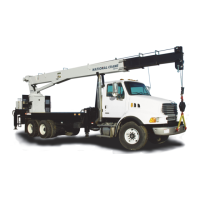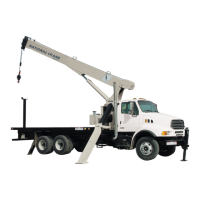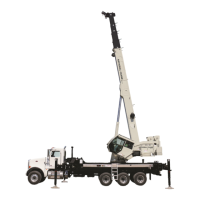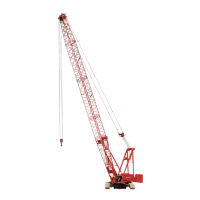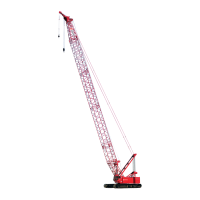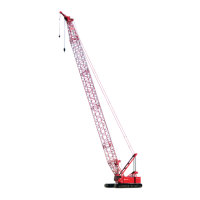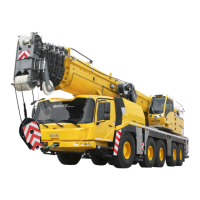SAFETY INFORMATION 1400H OPERATOR AND SERVICE MANUAL
1-12 Published 10-30-2014 Control # 040-09
Do not depend on grounding. Grounding of a crane affords
little or no protection from electrical hazards. The
effectiveness of grounding is limited by the size of the
conductor (wire) used, the condition of the ground, the
magnitude of the voltage and current present, and numerous
other factors.
Electrical Contact
If the crane should come in contact with an energized power
source, you must:
1. Stay in the crane work station. Don’t panic.
2. Immediately warn personnel in the vicinity to stay away.
3. Attempt to move the crane away from the contacted
power source using the crane’s controls which are likely
to remain functional.
4. Stay in the crane until the power company has been
contacted and the power source has been de-energized.
No one must attempt to come close to the crane or load
until the power has been turned off.
Only as a last resort should an operator attempt to leave the
crane upon contacting a power source. If it is absolutely
necessary to leave the operator’s station, jump completely
clear of the crane. Do not step off. Hop away with both feet
together. Do not walk or run.
Following any contact with an energized electrical source,
the Manitowoc distributor must be immediately advised of
the incident and consulted on necessary inspections and
repairs. Thoroughly inspect the wire rope and all points of
contact on the crane. Should the distributor not be
immediately available, contact Manitowoc Crane Care. The
crane must not be returned to service until it is thoroughly
inspected for any evidence of damage and all damaged parts
are repaired or replaced as authorized by your Manitowoc
distributor or Manitowoc Crane Care.
Special Operating Conditions and
Equipment
Never operate the crane during an electrical thunderstorm.
When operating near transmitter/communication towers
where an electrical charge can be induced into the crane or
load:
• The transmitter shall be deenergized OR,
• Tests shall be made to determine if an electrical charge
will be induced into the crane or load.
• The crane must be provided an electrical ground.
• If taglines are used, they must be non-conductive.
• Every precaution must be taken to dissipate induced
voltages. Consult a qualified RF (radio frequency)
Consultant. Also refer to local, state, and federal codes
and regulations.
When operating cranes equipped with electromagnets, you
must take additional precautions. Permit no one to touch the
magnet or load. Alert personnel by sounding a warning
signal when moving a load. Do not allow the cover of the
electromagnet power supply to be open during operation or
at any time the electrical system is activated. Shut down the
crane completely and open the magnet controls switch prior
to connecting or disconnecting magnet leads. Use only a
non-conductive device when positioning a load. Lower the
magnet to the stowing area and shut off power before
leaving the operator’s cab (if equipped) or operator’s station.
PERSONNEL HANDLING
The American Society of Mechanical Engineers issued a
new American National Standard entitled, Personnel Lifting
Systems, ASME B30.23-2011:
This Volume establishes the design criteria, equip-
ment characteristics, and operational procedures
that are required when hoisting equipment within
the scope of the ASME B30 Standard is used to lift
personnel. Hoisting equipment defined by the
ASME 830 Standard is intended for material han-
dling. It is not designed, manufactured, or intended
to meet the standards for personnel handling equip-
ment, such as ANSI/SIA A92 (Aerial Platforms).
The equipment and implementation requirements
listed in this Volume are not the same as that estab-
lished for using equipment specifically designed
and manufactured for lifting personnel. Hoisting
equipment complying with the applicable Volumes
of the ASME B30 Standard shall not be used to lift
or lower personnel unless there are no less hazard-
ous alternatives to providing access to the, area
where work is to be performed. The lifting or lower-
ing of personnel using ASME B30-compliant hoist-
ing equipment is prohibited unless all applicable
requirements of this volume have been met.
This new standard is consistent with the U.S. Department of
Labor, Occupational Safety and Health Administration
(OSHA) regulations for Construction that state, in
29CFRI926.1431:
General requirements. The use of a crane or der-
rick to hoist employees on a personnel platform is
prohibited, except when the erection, use, and dis-
mantling of conventional means of reaching the
worksite, such as a personnel hoist, ladder, stair-
way, aerial lift, elevating work platform or scaffold,
would be more hazardous or is not possible
because of structural design or worksite conditions.
Additional requirements for crane operations are stated in
ASME B30.5, Mobile and Locomotive Cranes, ASME B30.8,
Floating Cranes and Floating Derricks, and in OSHA
regulations 29CFRI910.180 for General Industry and
29CFRI926.1431 for Construction.
Use of a Manitowoc crane to handle personnel is acceptable
provided:
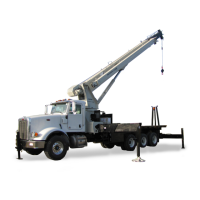
